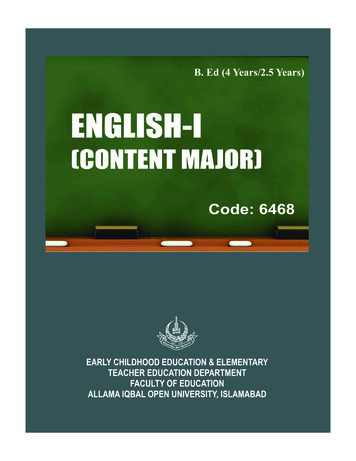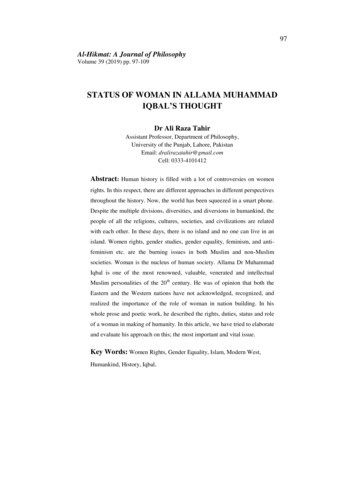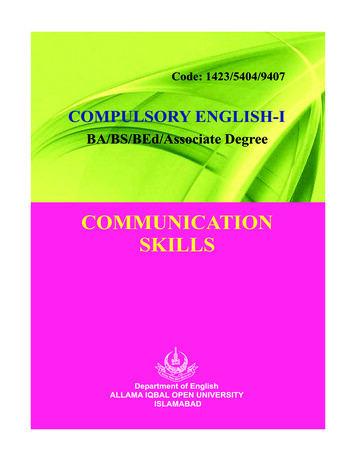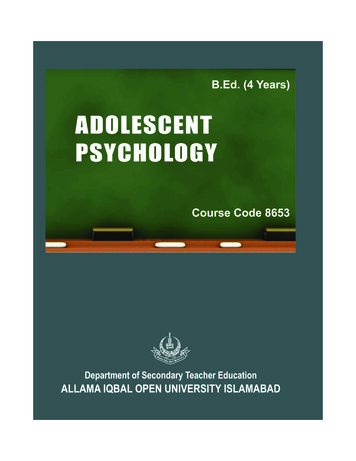
Transcription
ENGLISH-I(CONTENT MAJOR)B. Ed (4 Years/2.5 Years)Course Code: 6468Units: 1–9EARLY CHILDHOOD EDUCATION & ELEMENTARYTEACHER EDUCATION DEPARTMENTFACULTY OF EDUCATIONALLAMA IQBAL OPEN UNIVERSITYISLAMABAD
(All Rights Reserved with the Publisher)All rights reserved. No part of this publication may be reproduced, stored in retrievalsystem or transmitted in any form or by any means, electronic, mechanical, photocopyingRecording, scanning or otherwise, except as permitted under AIOU copyright ACT.First Printing . 2017Quantity . 10,000Typed by . Zahid Javed BajwaComposed by . Muhammad HameedPrinter. AIOU-Printing Press, H-8, IslamabadPublisher Islamabad . Allama Iqbal Open University, Islamabad.ii
COURSE TEAMChairman:Prof. Dr. Nasir MahmoodCourse Development Coordinator: Dr. Rehmat Ullah BhattiWriters:1. Khuram DadAssistant Professor, Department of EnglishGovt. Postgraduate College for Boys,Satellite Town, Rawalpindi2. Dr. Muhammad Ismail AbbasiAssistant Professor, Department of EnglishGovt. Postgraduate College for Boys,Satellite Town, Rawalpindi3. Mr. Adnan AshrafLecturer, Department of EnglishGovt. Gordon College, Rawalpindi4. Mr. Zafarullah ShaheenLecturer, Department of EnglishGovt. Gordon College, Rawalpindi5. Dr. Zafar IqbalSenior Research Officer, Planning DivisionMinistry of Capital Administration andDevelopment Division, Islamabad.Reviewer:1. Dr. Zafar IqbalSenior Research Officer, Planning DivisionMinistry of Capital Administration andDevelopment Division, Islamabad.Layout Design:Mr. Muhammad HameedW.P.O. AIOU-Printing Press, Islamabad.Editor:Ms. Humera EjazCourse Coordinator:Dr. Rahmat Ullah Bhattiiii
ACKNOWLEDGEMENTThe significance of English as a language is undeniable in this age. English enjoysa pivotal position and standard among the languages of the world. The teaching ofEnglish to the non-native speakers is a challenging tasks. In teaching a languagethere are certain skills that linguists have observed to be applicable in smoothteaching of a language. The Department of Early Childhood Education andElementary Teacher Education stresses upon the need of teaching such essentialskills to the prospective teachers of English language. In this regard the booktitled English-II contains such updated information and techniques regardingskills that can be utilized by the teachers in teachings the students. This bookreflects the efforts of many people. The Department of Early ChildhoodEducation and Elementary Teacher Education is thankful to all the members ofthe course team for writing units and giving comments and feedback to improvethe materials.It is significant in stating that course coordinator, Dr. Rahmat Ullah Bhatti, hasvery competently facilitated the whole process of course development. Heengaged and updated the course team according to the demands and objective ofthe course. All the communication is done effectively and timely. He personallyassisted the team in many concerning areas. Mr. Zahid Javed Bajwa andMr. Muhammad Hameed have very professionally completed the task oftyping/composing the contents of this book in short time.Special gratitude to our Vice-Chancellor Prof. Dr. Shahid Siddiqui for hisvisionary insight, professional support, mentorship and inspirational workenvironment for all of us to achieve academic excellence at university.Prof. Dr. Nasir MahmoodChairman/Dean Faculty of Educationiv
INTRODUCTIONIn this contemporary age world has assumed the shape of the global village wherecommunication among people of distinct languages and culture is possible via useof English language. English as a mode of communication has superseded theother languages therefore people of various backgrounds use this language as aneasy mode of expression. This book also contributes in the development ofEnglish as a language to teachers of non-native origin. This book providesdifferent techniques to be efficient in language skills like reading and writing. Itexplains the nature of reading skill and developing reading habit. The studentswill acquire different strategies that is going to improve their reading skills. Thebook also describes various barriers in reading and techniques to overcome them.The process of writing has been discussed in detail so that the students would beable to communicate effectively through different writing forms like letters,memorandums, application, reports and essays.For Pakistani students, English language has assumed the status of greatersignificance in their academic as well as professional life. As it is not only officiallanguage but also is the academic language. Educational institutes use this as acompulsory subject at various levels including: primary, elementary, secondary,higher secondary, gradation and post graduate levels. It is the language ofcommunication in official matters. In business and commerce English languagealso plays a significant role in terms of communication.v
OBJECTIVESAfter completion of the course, you will be able to:1.Understand the history and importance of English Language.2.Recombine the basic categories of words i.e. parts of speech.3.Analyze the sentence and identify its constituents i.e. phrase and clause.4.Identify and generate different kinds of sentences.5.Use the time of action i.e. Tense, its kinds and usage.6.Convert voice and narration of the sentences.7.Use punctuation to communicate effectively.8.Write paragraphs of various kinds.vi
CONTENTSPage No.Acknowledgement .ivIntroduction .vObjectives .viUnit–1: The History and Importance of English Language .1Unit–2: Parts of Speech-I .29Unit–3: Parts of Speech-II.59Unit–4: Sentence Structure .79Unit–5: Punctuation .99Unit–6: Tenses-I . 121Unit–7: Tenses-II . 137Unit–8: Voice and Narration . 159Unit–9: Paragraph Writing . 183vii
Unit–1THE HISTORY & IMPORTANCEOF ENGLISH LANGUAGEWritten by: Khuram DadReviewed by: Dr. Zafar Iqbal
CONTENTSPage No.Introduction .4Objectives .41.1What is Language.51.1.1 Double Articulation .51.2Syntax.61.3Features of Human Language .71.3.1 Language is Arbitrary .71.3.2 Language is Social .71.3.3 Language is Symbolic.81.3.4 Language is Systematic .81.3.5 Language is Vocal .81.3.6 Language is Non-Instinctive, Conventional .81.3.7 Language is Productive and Creative .8The Origin of Human Language .91.4.1 Language is Divine Creation .91.4.2 Natural Evolution Hypothesis.91.4.3 The Social Interaction Source .101.4.6 The Physical Adaptation Source .101.4.4 Teeth, Lips, Mouth, Larynx and Pharynx .111.4.5 The Tool-Making Source .121.5Beginning of English Language: The Old English Period.131.6The Middle English Period .161.6.1 Form and Function .161.42
1.7Modern English .181.7.1 The Early Modern English .181.7.2 The Late Modern English .18Significance of English in Pakistan .191.8.1 Colonial Background .191.8.2 English as a language Communication .201.8.3 Official Language .201.8.4 Academic Language .201.8.5 Language of Information Technology .21How are Language and Communication Related?.211.9.1 How to Communicate? .221.10 Why is Grammar Important? .221.10.1 Words .231.10.2 Phrases .231.10.3 Clauses .241.10.4 Sentence .241.10.5 Subject and Predicate .251.10.6 Four Kinds of Sentence .261.11 Self-Assessment Questions/Activities .261.12 Bibliography.281.81.93
INTRODUCTIONThis is the first book in the series of five books on English that you have to studyas part of your B.Ed syllabus. This introductory Unit establishes the concept oflanguage. It also traces the history of English language and the stages throughwhich it has reached it present status. This chapter also establishes role oflanguage in communication and significance of communication in our life. It alsotells the students that why is it important for us to learn English language. Theunit end on establishing significance of grammar in learning language andintroducing basic concepts of grammar.OBJECTIVESAfter studying this unit, you will be able to:1.Define language and explain features of human language.2.Explain the origin of human language.3.Trace the development of English language at its present stage.4.Describe the significance of English language in our country.5.Understand the importance of grammar in learning language.4
1.1 What is Language?Human beings can communicate with each other. You are able to exchangeknowledge, beliefs, opinions, wishes, threats, commands, thanks, promises,declarations, feelings – only our imagination sets limits. You can laugh to expressamusement, happiness, or disrespect, you can smile to express amusement,pleasure, approval, or bitter feelings, you can shriek to express anger, excitement,or fear, you can clench your fists to express determination, anger or a threat, youcan raise your eyebrows to express surprise or disapproval, and so on, but oursystem of communication before anything else is language. If we want to defineterm ‘language’ we can say that it is a system of communication based uponwords and the combination of words into sentences. Language is a fundamentalhuman faculty used for the expression of our thoughts and creative ideas, face-toface communication, scientific inquiry, and many other purposes. Communicationby means of language may be referred to as linguistic communication, the otherways mentioned above – laughing, smiling, shrieking, and so on – are types ofnon-linguistic communication. Verbal language includes words that attainexpression through sounds uttered by our vocal cords. On the other handnonverbal language includes signals and body gesture.Most or all non-human species can exchange information, but none of them areknown to have a system of communication with a complexity that in any way iscomparable to language possessed by human beings. Primarily, they communicatewith non-linguistic means resembling our smiling, laughing, yelling, clenching offists, and raising of eyebrows. Chimpanzees, gorillas, and orangutans can exchangedifferent kinds of information by emitting different kinds of shrieks, composingtheir face s in numerous ways, and moving their hands or arms in different gestures,but they do not have words and sentences like that of human beings. By moving incertain patterns, bees are apparently able to tell their fellow workers where to findhoney, but apparently not very much else. Birds sing different songs, whose mainfunctions are to defend their territory or to attract a mate.Language, as defined above, is an exclusively human property. Among thecharacteristics that make a relatively clear distinction between linguistic andnonlinguistic communication meaningful, two are particularly important: doublearticulation and syntax.1.1.1 Double ArticulationLanguages consist of tens of thousands of signs, which are combinations of formand meaning. Form in spoken languages is a sequence of sounds, in writtenlanguages for example a sequence of letters (depending upon what kind of writing5
system we are talking about) and in the sign languages of the deaf a certaincombination of gestures. Here, we shall concentrate on spoken languages, and oneexample of a sign is the English word Chair. Speakers of English associate acertain meaning with this form: ‘a separate seat for one person, typically with aback and four legs’. The form and the meaning together constitute a sign.Languages incorporate numerous signs, and the term double articulation refers tothe fact that the formal sides of these sign are built from a relatively small stockthat are usually between 10 and 100 of meaningless sounds.In English, the number of sounds is around 44, with 20 vowels and 24 consonants.There is no connection between the meaning and any of the sounds. In order toachieve the goal of communication you would need infinite number of sounds. Sowhat you do is, you combine these 44 sounds in different patterns and you cangenerate infinite number of words that enable you to communicate.In a “language” without double articulation, all signs would be constituted byindividual sounds, and the number of different sounds would be equal to thenumber of signs. One example would be a system of communication where eachsign is a specific cry. A human being would probably be able to distinguishseveral hundreds of cries, but such a system would not only be poor, but alsouneconomical, and extremely vulnerable to noise.1.2 SyntaxThe principle of double articulation has enabled human beings to create languageswith an impressively large number of signs, but the inventory of signs in alanguage is by necessity finite. Since the number of sounds in a language usually,is between 10 and 100, we could not have hundreds of thousands of differentsigns unless we allowed them to be extremely long, and there is anyway an upperlimit to the number of signs that a human being is able to remember. It would notbe very practical for a language to have separate signs for meanings like ‘mankilled lion’ and ‘lion killed man’. The total number of isolated signs in a humanlanguage is generally limited to roughly 10000–20000, and with this number ofsigns we cannot talk about an infinite number of meanings – unless we combinethem.The ingenious invention that enabled human beings to talk about everything theycan imagine is syntax. Syntax is used to put together signs expressing relativelysimple meanings into sign combinations expressing more complex meanings. Toexpress a meaning like ‘man killed lion’, you combine signs meaning ‘man’,‘kill’, ‘past’, and ‘lion’, and you combine the same signs in a different way to6
express the meaning ‘lion killed man’. The English sign sequences man killedlion and lion killed man are sentences, and the number of sentences in a languageis infinite. Take any sentence in a language, and it is always possible to make itlonger:Man killed lion the man killed the lion the woman said that the mankilled the lion the old woman said that the young man killed the lion theold woman said that the young man killed the lion that ate the antelope thegirl believed that the old woman said that the young man killed the lion that atethe antelope – and so on infinitely.Syntax is a mechanism that enables human beings to utter or understand aninfinite number of sentences constructed from a finite number of building blocks.Without syntax, you would not be able to express other meanings than thoseassociated with isolated signs, and the number of different meanings you wouldbe able to express, would be equal to the number of signs in the “language”.1.3 Features of Human LanguageLanguage is human so it differs from animal communication in several ways.Language can have scores of characteristics but the following are the mostimportant ones: language is arbitrary, productive, creative, systematic, vocalic,social, non-instinctive and conventional. These characteristics of language sethuman language apart from animal communication. Some of these features maybe part of animal communication; yet they do not form part of it in total.1.3.1 Language is ArbitraryLanguage is arbitrary in the sense that there is no inherent relation between thewords of a language and their meanings or the ideas conveyed by them. There isno reason why a female adult human being be called a woman in English, aurat inUrdu, Zen in Persian and Femine in French. The choice of a word selected tomean a particular thing or idea is purely arbitrary but once a word is selected for aparticular referent, it comes to stay as such. It may be noted that had language notbeen arbitrary, there would have been only one language in the world.1.3.2 Language is SocialLanguage is a set of conventional communicative signals used by humans forcommunication in a community. Language in this sense is a possession of a socialgroup, comprising an indispensable set of rules which permits its members torelate to each other, to interact with each other, to co-operate with each other; it is7
a social institution. Language exists in society; it is a means of nourishing anddeveloping culture and establishing human relations.1.3.3 Language is SymbolicLanguage consists of various sound symbols and their graphological counterpartsthat are employed to denote some objects, occurrences or meaning. Thesesymbols are arbitrarily chosen and conventionally accepted and employed. Wordsin a language are not mere signs or figures, but symbols of meaning. Theintelligibility of a language depends on a correct interpretation of these symbols.1.3.4 Language is SystematicAlthough language is symbolic, yet its symbols are arranged in a particularsystem. All languages have their system of arrangements. Every language is asystem of systems. All languages have phonological and grammatical systems,and within a system there are several sub-systems. For example, within thegrammatical system we have morphological and syntactic systems, and withinthese two sub-systems we have systems such as those of plural, of mood, ofaspect, of tense, etc.1.3.5 Language is VocalLanguage is primarily made up of vocal sounds only produced by a physiologicalarticulatory mechanism in the human body. In the beginning, it appeared as vocalsounds only. Writing came much later, as an intelligent attempt to represent vocalsounds. Writing is only the graphic representation of the sounds of the language.So the linguists say that speech is primary.1.3.6 Language is Non-Instinctive, ConventionalNo language was created in a day out of a mutually agreed upon formula by agroup of humans. Language is the outcome of evolution and convention. Eachgeneration transmits this convention on to the next. Like all human institutionslanguages also change and die, grow and expand. Every language then is aconvention in a community. It is non-instinctive because it is acquired by humanbeings. Nobody gets a language in heritage; he acquires it because he an innateability.1.3.7 Language is Productive and CreativeLanguage has creativity and productivity. The structural elements of humanlanguage can be combined to produce new utterances, which neither the speakernor his hearers may ever have made or heard before any, listener, yet which bothsides understand without difficulty. Language changes according to the needs ofsociety.8
Finally, language has other characteristics such as Duality referring to the twosystems of sound and meaning, Displacement which means the ability to talkacross time and space, Humanness which means that animals cannot acquire it,Universality which refers to the equilibrium across humanity on linguisticgrounds, Competence and Performance which means that language is innate andproduced is society and furthermore, language is culturally transmitted. It is learntby an individual from his elders, and is transmitted from one generation toanother. Thus using J. Firth’s term, language is a ‘polysystametic’. It is also opento be studied from multifaceted angles1.4 The Origin of Human LanguageBiologists refer to the modern human as homo sapiens, Latin for ‘wise man’, butthe possession of language is such an important part of the definition of themodern human that homo loquens ‘talking man’ would be an equally appropriatename. Concerning the origin of the first language, there are two main hypotheses,or beliefs. Neither can be proven or disproved given present knowledge.1.4.1 Language is Divine CreationThe first hypothesis acknowledges the role of divine influence upon humanbeings in creation of language. Many societies throughout history believed thatlanguage is the gift of the gods to humans. The most familiar is found in Genesis2:20, which tells us that Adam gave names to all living creatures. Holy Quran alsostates that “And He taught Adam all the names” Al-Baqra. This belief predicatesthat humans were created from the start with an innate capacity to use language.It cannot be proven that language is as old as humans, but it is definitely true thatlanguage and human society are inseparable. Wherever humans exist languageexists as it is the creation of human communication, interaction andcorrespondence regarding day to day matters among individuals and differentcommunities. Every Stone Age tribe ever encountered has a language equal toEnglish, Latin, or Greek in terms of its expressive potential and grammaticalcomplexity. Technologies may be complex or simple, but language is alwayscomplex.1.4.2 Natural Evolution HypothesisThe second hypothesis basis itself on the process of human evolution. At somepoint in their evolutionary development humans acquired a more sophisticatedbrain which made language invention and learning possible. In other words, atsome point in time humans evolved a device that Chomsky called languageacquisition device, whatever this may be in real physical terms. The simplevocalizations and gestures inherited from our primate ancestors then quickly gave9
way to a creative system of language--perhaps within a single generation or two.According to the natural evolution hypothesis, as soon as humans developed thebiological, or neurological, capacity for creative language, the culturaldevelopment of some specific system of forms with meanings would have been aninevitable next step.So far we have discussed about language and origin of language in general. Let usnow move to English language that is our primary concern in this course. First wewill look at the beginning of English language.1.4.3 The Social Interaction SourceAnother proposal involving natural sounds has been called the “yo-he-ho” theory.The idea is that the sounds of a person involved in physical effort could be thesource of our language, especially when that physical effort involved severalpeople and the inter-action had to be coordinated. So, a group of early humansmight develop a set of hums, grunts, groans and curses that were used when theywere lifting and carrying large bits of trees or lifeless hairy mammoths.The appeal of this proposal is that it places the development of human language ina social context. Early people must have lived in groups, if only because largergroups offered better protection from attack. Groups are necessarily socialorganizations and, to maintain those organizations, some form of communicationis required, even if it is just grunts and curses. So, human sounds, however theywere produced, must have had some principled use within the life and socialinteraction of early human groups.This is an important idea that may relate to the uses of humanly produced sounds.It does not, however, answer our question regarding the origins of the soundsproduced. Apes and other primates live in social groups and use grunts and socialcalls, but they do not seem to have developed the capacity for speech.1.4.4 The Physical Adaptation SourceInstead of looking at types of sounds as the source of human speech, we can lookat the types of physical features humans possess, especially those that are distinctfrom other creatures, which may have been able to support speech production. Wecan start with the observation that, at some early stage, our ancestors made a verysignificant transition to an upright posture, with bipedal (on two feet) locomotion,and a revised role for the front limbs.Some effects of this type of change can be seen in physical differences betweenthe skull of a gorilla and that of a Neanderthal man from around 60,000 years ago.10
The reconstructed vocal tract of a Neanderthal suggests that some consonant-likesound distinctions would have been possible. We have to wait until about 35,000years ago for features in reconstructions of fossilized skeletal structures that beginto resemble those of modern humans. In the study of evolutionary development,there are certain physical features, best thought of as partial adaptations, whichappear to be relevant for speech. They are streamlined versions of features foundin other primates. By themselves, such features would not necessarily lead tospeech production, but they are good clues that a creature possessing suchfeatures probably has the capacity for speech.1.4.5 Teeth, Lips, Mouth, Larynx and PharynxHuman teeth are upright, not slanting outwards like those of apes, and they areroughly even in height. Such characteristics are not very useful for ripping ortearing food and seem better adapted for grinding and chewing. They are alsovery helpful in making sounds such as f or v. Human lips have much moreintricate muscle interlacing than is found in other primates and their resultingflexibility certainly helps in making sounds like p or b. The human mouth isrelatively small compared to other primates, can be opened and closed rapidly,and contains a smaller, thicker and more muscular tongue which can be used toshape a wide variety of sounds inside the oral cavity. In addition, unlike otherprimates, humans can close off the airway through the nose to create more airpressure in the mouth. The overall effect of these small differences taken togetheris a face with more intricate muscle interlacing in the lips and mouth, capable of awider range of shapes and a more rapid and powerful delivery of sounds producedthrough these different shapes.The human larynx or “voice box” (containing the vocal folds or vocal cords)differs significantly in position from the larynx of other primates such asmonkeys. In the course of human physical development, the assumption of anupright posture moved the head more directly above the spinal column and thelarynx dropped to a lower position. This created a longer cavity called thepharynx, above the vocal folds, which acts as a resonator for increased range andclarity of the sounds produced via the larynx and the vocal tract. One unfortunateconsequence of this development is that the lower position of the human larynxmakes it much more possible for the h
English as a language to teachers of non-native origin. This book provides different techniques to be efficient in language skills like reading and writing. . This is the first book in the series of five books on English that you have to study as part of your B.Ed syllabus. This introductory Unit establishes the concept of language. It also .










